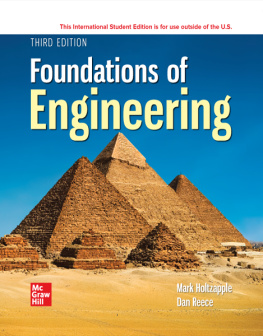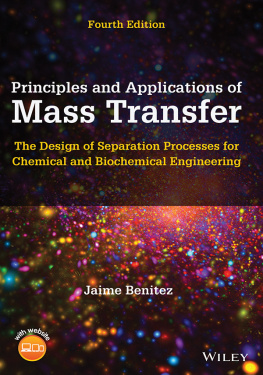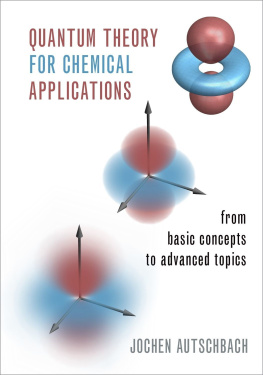David M. Himmelblau - Basic Principles and Calculations in Chemical Engineering, 9th Edition
Here you can read online David M. Himmelblau - Basic Principles and Calculations in Chemical Engineering, 9th Edition full text of the book (entire story) in english for free. Download pdf and epub, get meaning, cover and reviews about this ebook. year: 2022, publisher: Pearson, genre: Science. Description of the work, (preface) as well as reviews are available. Best literature library LitArk.com created for fans of good reading and offers a wide selection of genres:
Romance novel
Science fiction
Adventure
Detective
Science
History
Home and family
Prose
Art
Politics
Computer
Non-fiction
Religion
Business
Children
Humor
Choose a favorite category and find really read worthwhile books. Enjoy immersion in the world of imagination, feel the emotions of the characters or learn something new for yourself, make an fascinating discovery.

- Book:Basic Principles and Calculations in Chemical Engineering, 9th Edition
- Author:
- Publisher:Pearson
- Genre:
- Year:2022
- Rating:4 / 5
- Favourites:Add to favourites
- Your mark:
- 80
- 1
- 2
- 3
- 4
- 5
Basic Principles and Calculations in Chemical Engineering, 9th Edition: summary, description and annotation
We offer to read an annotation, description, summary or preface (depends on what the author of the book "Basic Principles and Calculations in Chemical Engineering, 9th Edition" wrote himself). If you haven't found the necessary information about the book — write in the comments, we will try to find it.
Basic Principles and Calculations in Chemical Engineering, 9th Edition — read online for free the complete book (whole text) full work
Below is the text of the book, divided by pages. System saving the place of the last page read, allows you to conveniently read the book "Basic Principles and Calculations in Chemical Engineering, 9th Edition" online for free, without having to search again every time where you left off. Put a bookmark, and you can go to the page where you finished reading at any time.
Font size:
Interval:
Bookmark:

David M. Himmelblau
Introduction
Introduction to Chemical Engineering
Chapter Objectives
Have a general knowledge of the evolution of chemical engineering.
Understand what chemical engineering is and the types of jobs chemical engineers perform.
Appreciate some of the issues associated with sustainability and green engineering.
Understand the importance of ethics in the practice of engineering.
Chemical engineers deal with processes that convert raw materials into useful products. Many times, these processes involve reactions followed by purification of the products, such as chemical reactions followed by concentration of the products, biological reactions followed by systems that recover and purify the products, or reactions and recovery of products on a nanometer scale. Overall, chemical engineers are process engineersthat is, chemical engineers deal with processes that produce a wide range of products.
Chemical engineering evolved from the industrial applications of chemistry and separation science (i.e., the study of separating components from mixtures) primarily in the refining and chemical industry, which we refer to here as the . The first high-volume chemical process was implemented in 1823 in England for the production of soda ash, which was used to produce glass and soap.
In 1887, a British engineer, George E. Davis, presented a series of lectures on chemical engineering that summarized industrial practice in the chemical industry in Great Britain. These lectures stimulated interest in the United States and to some degree led to the formation of the first chemical engineering curriculum at MIT in 1888. Over the next 10 to 15 years, a number of US universities embraced the field of chemical engineering by offering curriculum in this area. In 1908, the American Institute of Chemical Engineers was formed and since has served to promote and represent the interests of the chemical engineering community.
Mechanical engineers understood the mechanical aspects of process operations, including fluid flow and heat transfer, but they did not have backgrounds in chemistry. Conversely, chemists understood chemistry and its ramifications but lacked the process skills. In addition, neither mechanical engineers nor chemists had backgrounds in separation science, which is critically important to the CPI. As a result, the study of chemical engineering evolved to meet these industrial needs.
The acceptance of the horseless carriage, which began commercial production in the 1890s, created a demand for gasoline that ultimately fueled exploration for oil. In 1901, Patillo Higgins, a Texas geologist, and Anthony F. Lucas, a mining engineer, later to be known as wildcatters, led a drilling operation that brought in the Spindletop Well just south of Beaumont, Texas. At the time, Spindletop produced more oil than all the other oil wells in the United States. Moreover, a whole generation of wildcatters was born, resulting in a dramatic increase in the domestic production of crude oil, which created a need for larger-scale, more modern approaches to crude refining. As a result, a market developed for engineers who could assist in the design and operation of processing plants for the CPI. The success of oil exploration was to some degree driven by the demand for gasoline for the automobile industry, and ultimately, it led to the widespread adoption of automobiles for the general population due to the resulting lower cost of gasoline.
These early industrial chemists/chemical engineers had few analytical tools available to them and largely depended on their physical intuition to perform their jobs as process engineers. Slide rules were used for performing calculations, and by the 1930s and 1940s, a number of nomographs were developed to assist them in the design and operation analysis of processes for the CPI. Nomographs are charts that provide a concise and convenient means to represent physical property data (e.g., boiling point temperatures or heat of vaporization) and can also be used to provide simplified solutions of complex equations (e.g., pressure drop for flow in a pipe). The availability of computing resources in the 1960s was the beginning of computer-based technology that is commonplace today. For example, since the 1970s, have allowed engineers to design complete processes by specifying only a minimum of information; all the tedious and repetitive calculations are done by the computer in an extremely short period of time, allowing the design engineer to focus on the task of developing the best possible process design.
In 1959, Professors Bird, Stewart, and Lightfoot of the Department of Chemical Engineering at the University of Wisconsin published their textbook Transport Phenomena that covered fluid flow, heat transfer, and mass transfer. This book was widely adopted throughout the chemical engineering community and provided a much more mathematical and abstract analysis of these topics than had previously been used. The widespread use of this book ushered in a much more analytical approach to chemical engineering than the more empirical approach that preceded it.
During the period 196080, the CPI also made the transition from an industry based on innovation in which the profitability of a company depended to a large degree on developing new products and new processing approaches to a more mature commodity industry in which the financial success of a company depended on making their products using established technology more efficiently, resulting in less expensive products.
Globalization of the CPI markets began in the mid-1980s and led to increased competition. At the same time, development in computer hardware made it possible to apply process automation more easily and reliably than ever before. These automation projects provided improved product quality while increasing production rates and overall production efficiency with relatively little capital investment.
Beginning in the mid-1990s, new areas came on the scene that took advantage of the fundamental skills of chemical engineers, including the microelectronic industry, the pharmaceutical industry, the biomedical industry, and nanotechnology. Clearly, the analytical skills and the process training made chemical engineers ideal contributors to the development of the production operations for these industries. In the 1970s, more than 80% of graduating chemical engineers took jobs with the CPI and government. By 2000, that number had dropped to 50% due to increases in the number taking jobs with biotechnology companies, pharmaceutical/health care companies, and electronics and materials companies.
Chemical engineers perform a wide range of jobs. Moreover, during your career, you are likely to have a number of different types of jobs. Following are the general types of jobs that chemical engineers perform:
Operations: Operations engineers, or process engineers, are the first line of technical support for a processing plant. These engineers spend a lot of their time in the plant monitoring the operations and solving operational problems. When a serious technical problem occurs in the middle of the night, the operations engineer for that process is called in to resolve the problem. Many young chemical engineers start out as operations engineers for a few years so that they can become familiar with plant operations before they move to other assignments. This job also provides companies a view of how young engineers handle responsibility as well as how effectively they are able to work with others.
Font size:
Interval:
Bookmark:
Similar books «Basic Principles and Calculations in Chemical Engineering, 9th Edition»
Look at similar books to Basic Principles and Calculations in Chemical Engineering, 9th Edition. We have selected literature similar in name and meaning in the hope of providing readers with more options to find new, interesting, not yet read works.
Discussion, reviews of the book Basic Principles and Calculations in Chemical Engineering, 9th Edition and just readers' own opinions. Leave your comments, write what you think about the work, its meaning or the main characters. Specify what exactly you liked and what you didn't like, and why you think so.




